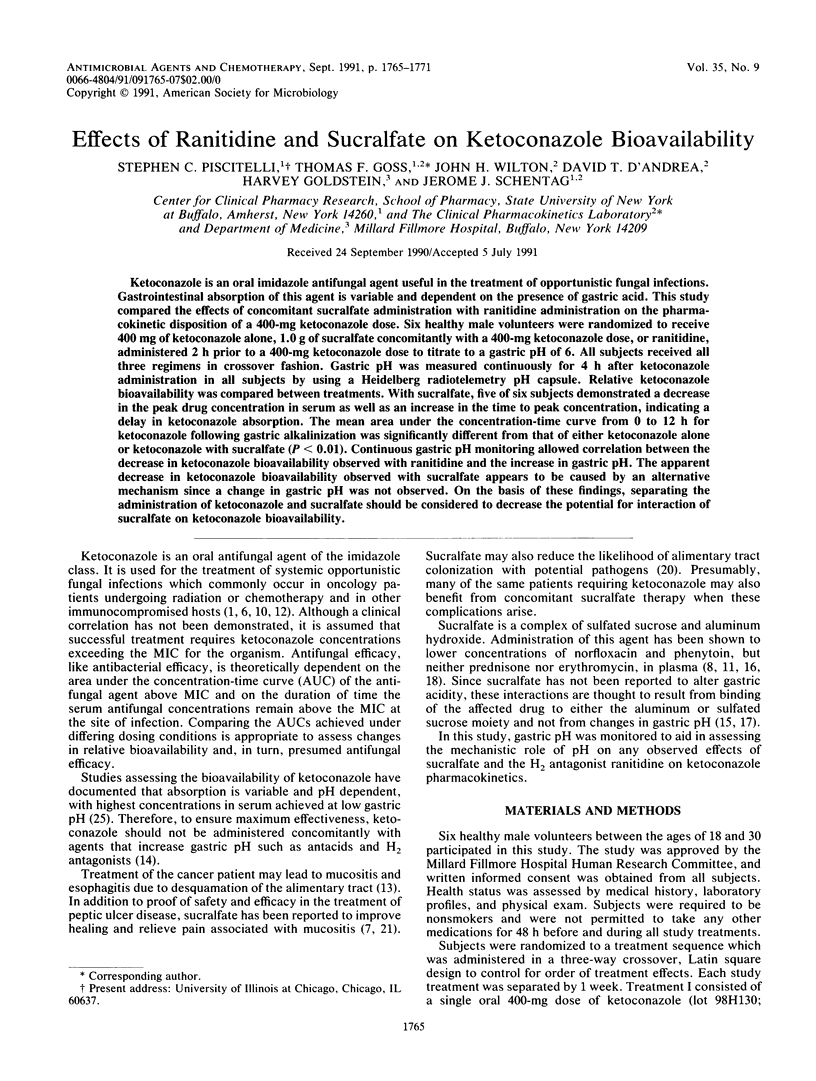Abstract
Ketoconazole is an oral imidazole antifungal agent useful in the treatment of opportunistic fungal infections. Gastrointestinal absorption of this agent is variable and dependent on the presence of gastric acid. This study compared the effects of concomitant sucralfate administration with ranitidine administration on the pharmacokinetic disposition of a 400-mg ketoconazole dose. Six healthy male volunteers were randomized to receive 400 mg of ketoconazole alone, 1.0 g of sucralfate concomitantly with a 400-mg ketoconazole dose, or ranitidine, administered 2 h prior to a 400-mg ketoconazole dose to titrate to a gastric pH of 6. All subjects received all three regimens in crossover fashion. Gastric pH was measured continuously for 4 h after ketoconazole administration in all subjects by using a Heidelberg radiotelemetry pH capsule. Relative ketoconazole bioavailability was compared between treatments. With sucralfate, five of six subjects demonstrated a decrease in the peak drug concentration in serum as well as an increase in the time to peak concentration, indicating a delay in ketoconazole absorption. The mean area under the concentration-time curve from 0 to 12 h for ketoconazole following gastric alkalinization was significantly different from that of either ketoconazole alone or ketoconazole with sucralfate (P less than 0.01). Continuous gastric pH monitoring allowed correlation between the decrease in ketoconazole bioavailability observed with ranitidine and the increase in gastric pH. The apparent decrease in ketoconazole bioavailability observed with sucralfate appears to be caused by an alternative mechanism since a change in gastric pH was not observed. On the basis of these findings, separating the administration of ketoconazole and sucralfate should be considered to decrease the potential for interaction of sucralfate on ketoconazole bioavailability.
Full text
PDF






Selected References
These references are in PubMed. This may not be the complete list of references from this article.
- Caille G., du Souich P., Gervais P., Besner J. G., Vezina M. Effects of concurrent sucralfate administration on pharmacokinetics of naproxen. Am J Med. 1987 Sep 28;83(3B):67–73. doi: 10.1016/0002-9343(87)90831-x. [DOI] [PubMed] [Google Scholar]
- Espinel-Ingroff A., Shadomy S. In vitro and in vivo evaluation of antifungal agents. Eur J Clin Microbiol Infect Dis. 1989 Apr;8(4):352–361. doi: 10.1007/BF01963469. [DOI] [PubMed] [Google Scholar]
- Fainstein V., Bodey G. P., Elting L., Maksymiuk A., Keating M., McCredie K. B. Amphotericin B or ketoconazole therapy of fungal infections in neutropenic cancer patients. Antimicrob Agents Chemother. 1987 Jan;31(1):11–15. doi: 10.1128/aac.31.1.11. [DOI] [PMC free article] [PubMed] [Google Scholar]
- Ferraro J. M., Mattern J. Q., 2nd Sucralfate suspension for stomatitis. Drug Intell Clin Pharm. 1984 Feb;18(2):153–153. doi: 10.1177/106002808401800214. [DOI] [PubMed] [Google Scholar]
- Gambertoglio J. G., Romac D. R., Yong C. L., Birnbaum J., Lizak P., Amend W. J., Jr Lack of effect of sucralfate on prednisone bioavailability. Am J Gastroenterol. 1987 Jan;82(1):42–45. [PubMed] [Google Scholar]
- Gold J. W. Opportunistic fungal infections in patients with neoplastic disease. Am J Med. 1984 Mar;76(3):458–463. doi: 10.1016/0002-9343(84)90665-x. [DOI] [PubMed] [Google Scholar]
- Hall T. G., Cuddy P. G., Glass C. J., Melethil S. Effect of sucralfate on phenytoin bioavailability. Drug Intell Clin Pharm. 1986 Jul-Aug;20(7-8):607–611. doi: 10.1177/106002808602000726. [DOI] [PubMed] [Google Scholar]
- Hart P. D., Russell E., Jr, Remington J. S. The compromised host and infection. II. Deep fungal infection. J Infect Dis. 1969 Aug;120(2):169–191. doi: 10.1093/infdis/120.2.169. [DOI] [PubMed] [Google Scholar]
- McGraw B. F., Hesterlee E. J., Lanza F. L., Tesler M. A. In vitro and In vivo evaluations of a tableted antacid and sucralfate, a new antiulcer agent. Am J Gastroenterol. 1981 Nov;76(5):412–415. [PubMed] [Google Scholar]
- Miller L. G., Prichard J. G., White C. A., Vytla B., Feldman S., Bowman R. C. Effect of concurrent sucralfate administration on the absorption of erythromycin. J Clin Pharmacol. 1990 Jan;30(1):39–44. doi: 10.1002/j.1552-4604.1990.tb03436.x. [DOI] [PubMed] [Google Scholar]
- Nagashima R. Development and characteristics of sucralfate. J Clin Gastroenterol. 1981;3(Suppl 2):103–110. [PubMed] [Google Scholar]
- Parpia S. H., Nix D. E., Hejmanowski L. G., Goldstein H. R., Wilton J. H., Schentag J. J. Sucralfate reduces the gastrointestinal absorption of norfloxacin. Antimicrob Agents Chemother. 1989 Jan;33(1):99–102. doi: 10.1128/aac.33.1.99. [DOI] [PMC free article] [PubMed] [Google Scholar]
- Riley C. M., James M. O. Determination of ketoconazole in the plasma, liver, lung and adrenal of the rat by high-performance liquid chromatography. J Chromatogr. 1986 Apr 25;377:287–294. doi: 10.1016/s0378-4347(00)80784-7. [DOI] [PubMed] [Google Scholar]
- Shenep J. L., Kalwinsky D. K., Hutson P. R., George S. L., Dodge R. K., Blankenship K. R., Thornton D. Efficacy of oral sucralfate suspension in prevention and treatment of chemotherapy-induced mucositis. J Pediatr. 1988 Oct;113(4):758–763. doi: 10.1016/s0022-3476(88)80397-4. [DOI] [PubMed] [Google Scholar]
- Stavney L. S., Hamilton T., Sircus W., Smith A. N. Evaluation of the pH-sensitive telemetering capsule in the estimation of gastric secretory capacity. Am J Dig Dis. 1966 Oct;11(10):753–760. doi: 10.1007/BF02233835. [DOI] [PubMed] [Google Scholar]
- Steinberg W. H., Mina F. A., Pick P. G., Frey G. H. Heidelberg capsule. I. In vitro evaluation of a new instrument for measuring intragastric pH. J Pharm Sci. 1965 May;54(5):772–776. doi: 10.1002/jps.2600540522. [DOI] [PubMed] [Google Scholar]
- Van Der Meer J. W., Keuning J. J., Scheijgrond H. W., Heykants J., Van Cutsem J., Brugmans J. The influence of gastric acidity on the bio-availability of ketoconazole. J Antimicrob Chemother. 1980 Jul;6(4):552–554. doi: 10.1093/jac/6.4.552. [DOI] [PubMed] [Google Scholar]
- Yarbrough D. R., 3rd, McAlhany J. C., Weidner M. G., Jr, Cooper N. Evaluation of the Heidelberg pH capsule. Method of tubeless gastric analysis. Am J Surg. 1969 Feb;117(2):185–192. doi: 10.1016/0002-9610(69)90303-1. [DOI] [PubMed] [Google Scholar]


